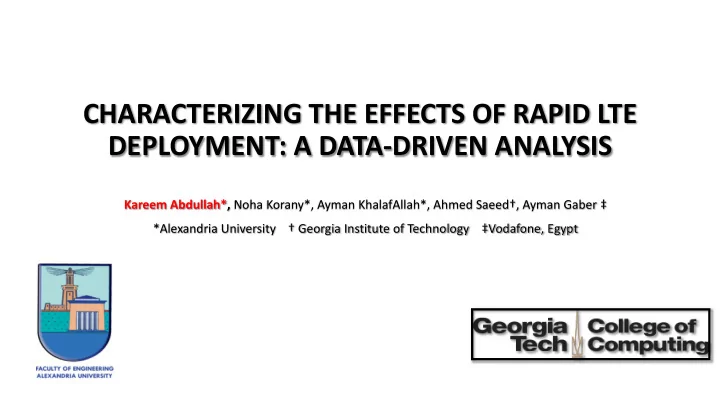

CHARACTERIZING THE EFFECTS OF RAPID LTE DEPLOYMENT: A DATA-DRIVEN ANALYSIS Kareem Abdullah*, Noha Korany*, Ayman KhalafAllah*, Ahmed Saeed†, Ayman Gaber ‡ *Alexandria University † Georgia Institute of Technology ‡Vodafone, Egypt
Data Continue to Grow with around 50% YoY Driven by Smartphone Penetration and Higher usage per sub* 2 * Ericsson mobility report, Q4-2018
4G NOT 5G! • 3G Shutdown is on its way, re-farming the allocated spectrum from 3G to 4G Ø Global mobile data traffic will increase seven-fold between 2017 and 2022, with 4G traffic share of 71 % and 5G with 11.8 %.* Ø Global 4G (LTE) devices market value to Increase from US$ 344.8 Bn in 2016 to US$ 926.1 Bn by 2024* • New 4G deployment in developing countries • Deployments in community-operated cellular networks that service underdeveloped regions Ericsson mobility report, Q2-2019 3 *Cisco Visual Networking Index: Global Mobile Data Traffic Forecast Update, 2017–2022 White Paper
Spectrum, Most Valuable Asset for Mobile Operators • Operators always focus on increasing spectrum efficiency (bps/cell/Hz), adopting new technology generations HSDPA+ 4G HSDPA EDGE WCDMA 5G HSDPA HSDPA+ GSM/GPRS GPRS/EDGE NGN GSM/GPRS WCDMA 4G+ HSDPA+ HSDPA 4G EDGE WCDMA 5G 48Kbps 240Kbps 384Kbps 1.8/3.6/7.2/14.4 Mbps 21/28/42 Mbps 150 Mbps 1Gbps 4 Hence, operators replace 3G with 4G for better spectrum utilization
4G DEPLOYMENT • Standard 4G deployment involves many steps Ø Network dimensioning of user demand and density Ø Desired Quality of Service (QoS) Ø Plan optimal radio parameters through rigorous pre and post activation optimization procedures This is an expensive operation! • Rapid deployment reuses 3G sites as is, only changing software (Single RAN). • Why Rapid Deployment? Ø Reducing time to market Ø Cost efficiency 5
3G AND 4G ARE SIGNIFICANTLY DIFFERENT 4G is robust for intra-cell interference but inter cell interference could dramatically affect 4G performance 6
OBJECTIVE Ø Characterizing the side effects of the rapid deployment approach Ø Developing a data-driven approach to mitigate the negative side effects 7
OUTLINES • Measurement Methodology • Key Observations • Handling the pitfalls of rapid deployment • Conclusion 8
OUTLINES • Measurement Methodology • Key Observations • Handling the pitfalls of rapid deployment • Conclusion 9
MEASUREMENT METHODOLOGY • Key Performance Indicators (KPIs) collected from a cluster of cells spanning two major cities, over two consecutive months • Data Collected before the post activation optimization taking place. • KPIs measured at the eNodeBs, capturing both network KPIs and per-cell aggregate end-user KPIs. 10
MEASUREMENT METHODOLOGY (CONT.) • A model was devised to classify the cells into degraded or not based on the avg user throughput. • Feature selection algorithms were used to select the most relevant KPIs for our analysis. 11 Estimation accuracy improvement using sequential forward selection, the first six features are enough to provide best estimation accuracy
SELECTED FEATURES a) Radio Conditions Indicators • High-order modulation penetration Ratio (HOMPR) It’s the percentage of traffic having users enjoying 64-QAM modulation b) Capacity Indicators • Resource Block Utilization (PRB)% It’s the Radio spectrum resources utilization 12
OUTLINES • Measurement Methodology • Key Observations • Handling the pitfalls of rapid deployment • Conclusion 13
RADIO CONDITIONS, THE BEST INDICATORS KPI Correlation with Average User (Whole Cluster) Throughput 0.454163 HOMPR -0.316519 BLER -0.311759 PRB Utilization -0.18782 14 # of Active Users High-Order MCS Penetration % is the best indicator for the problem
RADIO CONDITIONS, THE BEST INDICATORS Normally, the best indicators should be capacity indicators, which is not the case here, due to rapid deployment KPI Correlation with Average User (Whole Cluster) Throughput 0.454163 HOMPR -0.316519 BLER -0.311759 PRB Utilization -0.18782 15 # of Active Users High-Order MCS Penetration % is the best indicator for the problem
BAD RADIO CONDITIONS ARE PREVALENT 17
BAD RADIO CONDITIONS ARE PREVALENT Rapid deployment without post-activation optimization causes bad radio conditions 18 in m ore than 50% of studied cells
SIDE EFFECTS LIMITED TO OVERLAPPING AREAS
SIDE EFFECTS LIMITED TO OVERLAPPING AREAS Reducing cell overlap can significantly improve the performance of the affected cells
OUTLINES • Measurement Methodology • Key Observations • Handling the pitfalls of rapid deployment • Conclusion 21
HANDLING PITFALLS OF RAPID DEPLOYMENT • Managing cells affected by rapid deployment has two steps: Ø Detection Ø Tuning • Detection relies on low HOMPR as a proxy • Physical optimization is used to tune the affected cells Illustration of cell physical parameters.
HANDLING PITFALLS OF RAPID DEPLOYMENT 23
HANDLING PITFALLS OF RAPID DEPLOYMENT 24 Improving radio conditions by physical optimization led to average user throughput enhancement up to 114%.
OUTLINES • Measurement Methodology • Key Observations • Handling the pitfalls of rapid deployment • Conclusion 25
CONCLUSION • Rapid deployment provides lower cost and faster LTE rollout at the expense of users performance • Underperforming cells can be detected through data-driven analysis and remedied through physical optimization 26
Thank you! Questions? 27
Recommend
More recommend